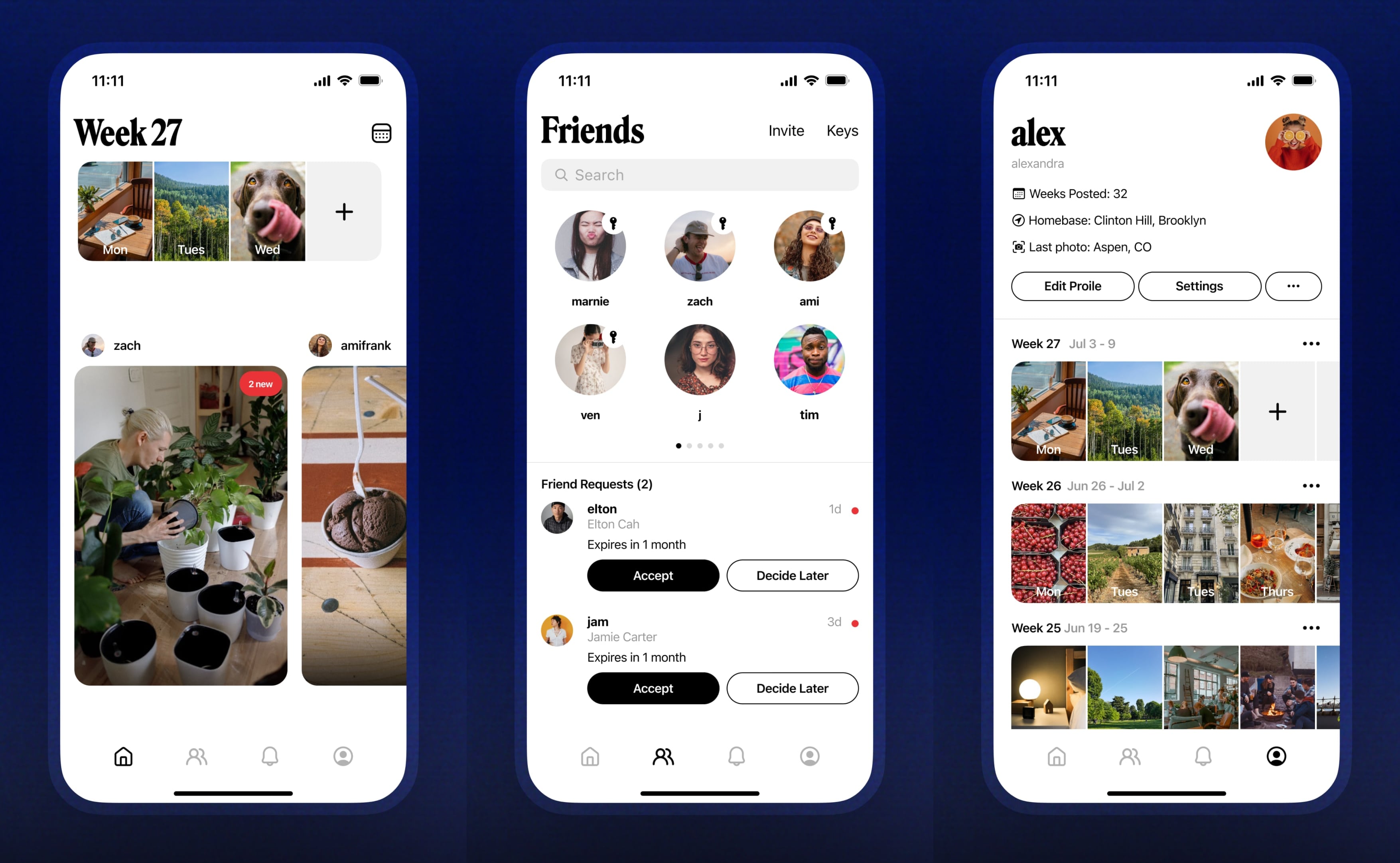When is the last time you uploaded your vacation photos to a social network? And what app do you use to keep up with long-distance friends? A new social app called Retro wants to help you share what’s happening in your life with a small group of friends and family members.
I have been using Retro for a few days and it feels like a deeply personal experience that has the potential to put a smile on your face — something that rarely happens on Facebook, Instagram, TikTok, Twitter or YouTube.
The app will be available very soon on iOS. In the meantime, anyone can sign up to the waitlist and reserve their username.
In 2018, I wrote that social networks were no longer social as they had become too much focused on engagement and growth. “Now that we’ve reached a social network dead end, it’s time to build our own digital house,” I wrote at the time.
In many ways, private groups on messaging apps have become the default way to share photos with groups of friends or your extended family. But that solution doesn’t scale well.
“The thing that we’re trying to do is just be the single best place to catch up with friends and family,” Retro’s co-founder and CEO Nathan Sharp told me. “One of the things that Retro does to make that process easier is you don’t have to ask yourself — which message thread do I have to share this to? And manage three to four to five threads of different, non-overlapping groups of friends.”
A track record in the consumer social space
Retro has been founded by two former Instagram team members. Nathan Sharp, Retro’s CEO, has played an instrumental role in the launch of Stories on Instagram back in 2016. He then assumed different roles in product management and growth for several Meta products.
Retro’s CTO Ryan Olson was also working on Instagram when the social app added Stories. He was involved with many Instagram launches over the years as the iOS tech lead. More recently, Olson was Instagram’s director of engineering until May 2022.
Retro has already raised a pre-seed and seed round with Thrive Capital, Dylan Field, Scribble Ventures, Box Group, Imaginary Ventures, Coalition, Conviction, Copper, Positive Sum and several angel investors. The company doesn’t want to share how much money it has raised.

Image Credits: Retro
“One of our favorite moments in building [Instagram Stories] was this moment before we actually launched to the public,” Sharp said. “It was amazing to see our friends who were also coworkers starting to share photos as Stories in ways that they weren’t sharing anywhere else. And you just got to know them much better. And it just felt like this magical time when you had a window into someone else’s life that you didn’t have before.”
But if you have an Instagram account, you know that Stories have changed significantly over the years. In addition to your best friends, chances are you also follow creators, media publications, concert venues, restaurants and brands on Instagram.
“A lot of times what you see over time is that whenever an app hosts both types of content, the entertainment content from creators sometimes crowds out the content from friends,” Sharp said.
How Retro works
Retro is a photo-sharing app. That might sound a bit old school in 2023, but many entrepreneurs are still trying to crack the code when it comes to photo-sharing on mobile. Some newer apps, such as BeReal and Locket, have found ways to innovate on this challenge that is as old as the smartphone.
When you open Retro, you won’t find any button to capture photos and videos. In fact, there’s no way to create a post either. Instead, users add photos and videos to this week’s film strip that is displayed at the top of the screen. And sharing is simple, as easy as selecting a bunch of photos in a private conversation and hitting send.
“We want our composer to be as lightweight and low pressure as possible. So you can select multiple things very quickly. You don’t have to edit them. You don’t have to filter them, crop, caption. You can just kind of say ‘here’s the 10 things I did this week’ and post them within a few seconds,” Olson told me.

Image Credits: Retro
Essentially, Retro encourages you to select the most meaningful photos and videos in your camera roll. When it’s time to capture a photo, you can just use the default camera on your phone. You don’t need to open a separate app and change your habits.
“[Users] already know and understand their system camera really well. They can easily access it from their lock screen,” Sharp said. “We wanted to be different and opinionated — we wanted to encourage people to stay in the moment. With some different apps, a lot of times you feel some pressure to kind of annotate or use a creative tool. You stop your dinner, or you stop what you’re doing to filter it, caption it and then share it.”
It’s in the name of the app. Retro lets you share photos retrospectively, at the end of the day or even at the end of the week.
As your friends start adding photos, Retro automatically regroups all the moments that they’ve shared that week. At any point in time, you can tap on someone’s card and view all the photos and videos of the week. Some users are only going to share two photos while others will be more enthusiastic and share dozens of photos.
“For other people, we put their full stories behind a single card,” Sharp told me. “They don’t feel like they can kind of spam the feed or create noise in the feed by sharing too much. So basically there’s one card for you, whether you’ve shared one photo or 50 photos, and people who share 50 photos feel more comfortable.”
Swapping photo journals
As you start using Retro more regularly, your profile will look more and more like a good old photo journal with your life’s most memorable moments. And it turns out that other users are also doing the same thing.
By default, you can view your friends’ last four weeks of photos, which means that you can share photos without feeling too much pressure as they’ll be hidden after four weeks. Unlike photo albums on Facebook, they won’t be viewable for years and years. Unlike Instagram stories, they won’t disappear after 24 hours either.
“There’s almost like a pendulum of ephemerality. During the early days of social, everything was permanent. And then after a few years of that, you started to be like: ‘Oh, maybe I don’t want that.’ Maybe that photo from five years ago is actually embarrassing to me now,” Olson said.
“And so it’s swung really hard towards this 24-hour ephemerality where things just disappear very quickly, which is maybe too far. Maybe it’s okay if I can see something from a week ago or a month ago. And we’re trying to hit this sweet spot in the middle where you can still catch up on what someone’s done recently, but there’s kind of comfort in knowing that it’s not there forever.”
Of course, in some cases, you may want to share more than that. If your spouse or your BFF is also using Retro, you can give a key to your full profile. Your key holders will be able to see back more than 4 weeks in the past.
Over the next few months, Retro will be able to tap into this highly relevant collection of photos. For instance, the startup will be able to resurface important memories of the past year or two. Retro could even leverage its social graph to revive important moments that you spent with your closest friends.
Giving that kind of nudge makes you feel comfortable because you know everybody else is in the same boat and needs to share just a little moment to participate Nathan Sharp
But Retro only works if everyone is posting something on the platform. Some people will be oversharers, but at least everyone should participate. That’s why the startup nudges you to share at least one photo per week to view your friends’ photos.
“By nudging everybody to share, it lowers the pressure of what you feel like you have to share. Giving that kind of nudge makes you feel comfortable because you know everybody else is in the same boat and needs to share just a little moment to participate,” Sharp said.
And this is key to understanding Retro’s future. Having the perfect concept paired with a great design won’t be enough to turn this neat social app into a global consumer success. Retro will have to attract enough users and keep them engaged over the long haul so that it feels like a happy place on your phone.
“We often talk about this metaphor of a wedding dance floor as a great way to think about consumer social space. A lot of things have to be right to have a successful wedding dance floor. You have to know the song, you have to know how to dance to it,” Sharp said.
“There usually has to be other people out on the floor first. Usually they can’t be like professional dancers or people that are so good that you can’t really compete with them in terms of acrobatic dancing. But another important component is that you don’t want a bunch of people sitting around at the edge of the room at tables, looking at the people dancing and judging.”
Retro is a deeply personal photo journaling app for close friends by Romain Dillet originally published on TechCrunch
DUOS





